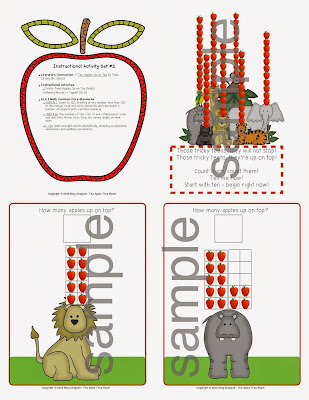We started in September with a 2-week unit on apples. Here is an overview of the units and the books that could link to the instructional activities.
Throughout the unit, we studied the life cycle of the apple and learned about the seasons of apple trees. We did a lot of writing, studied globes and maps and used apple math to reinforce key 1st grade number skills. I got to use some of my favorite apple themed books, including The Seasons of Arnold's Apple Tree and How to Make an Apple Pie and See the World.
Here are some sample images from the unit.


Take a look at my tpt page for a more detailed overview!
We continued our farm theme with a unit on the The Little Red Hen. I love teaching with familiar folk tales because there are so many versions available. It's a great opportunity to compare story elements. At the same time, I stock our classroom library with non-fiction texts so we can study the animals featured in the folk tales.
I wanted my students to have lots of opportunities to read the story independently, so I wrote an emerging reader that all my students could easily decode. I also include a more advanced reader with my own southwestern version, The Little Brown Roadrunner. We spent some time circling the sight words the kids have learned so far, and they were amazed by how much they've learned. It was a real confidence booster for some of my more reluctant readers.
I've included a read-aloud version you can use with your students to compare it with traditional versions.
In addition, there were many writing opportunities with this unit. My kids wrote their own versions of The Little Red Hen with the "Build a Book" lesson. They also wrote opinion paper about their favorite version of the folk tale, and wrote informative papers about chickens. We also delved more deeply into "how to" informative writing with this unit. I included brainstorming, drafting, editing and final draft papers for each writing activity so that my students would have plenty of practice with the writing process.
Take a look at my tpt page for a more detailed overview!
I've included a read-aloud version you can use with your students to compare it with traditional versions.
To give my students practice with retelling the story, I set up a center with sequencing cards (color and black and white versions) that they put into order. They wrote a summary under each of the 8 cards to give them more practice with summarizing beginning, middle and ending parts of the plot. They also worked on retelling using laminated story pieces.
In addition, there were many writing opportunities with this unit. My kids wrote their own versions of The Little Red Hen with the "Build a Book" lesson. They also wrote opinion paper about their favorite version of the folk tale, and wrote informative papers about chickens. We also delved more deeply into "how to" informative writing with this unit. I included brainstorming, drafting, editing and final draft papers for each writing activity so that my students would have plenty of practice with the writing process.
Take a look at my tpt page for a more detailed overview!
I wanted my students to read the folktale on their own, so I wrote an emerging version and a more advanced version for my students in a reproducible format.



















Very nice article, thanks for more information.
ReplyDeleteac marriage halls in chennai